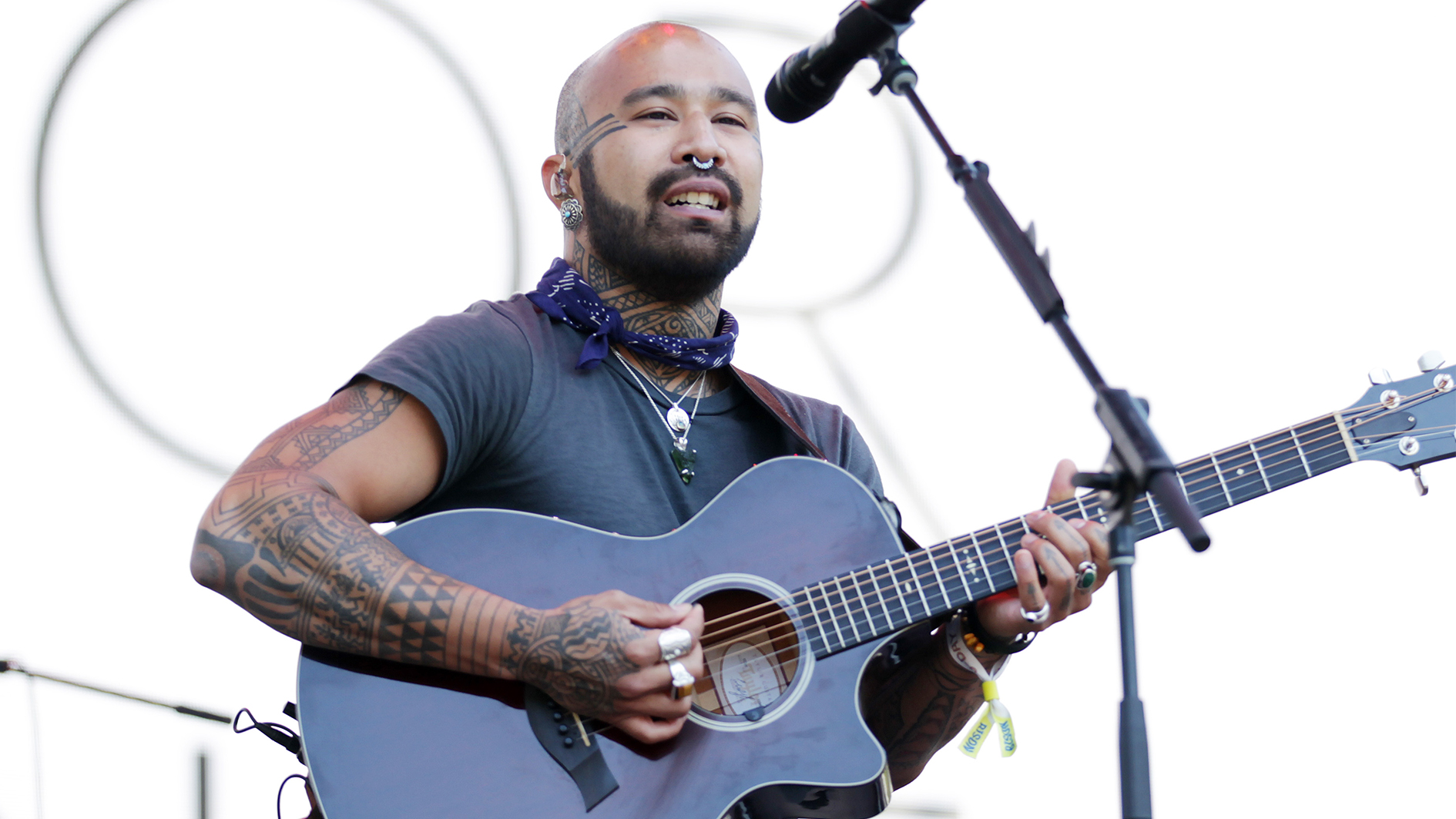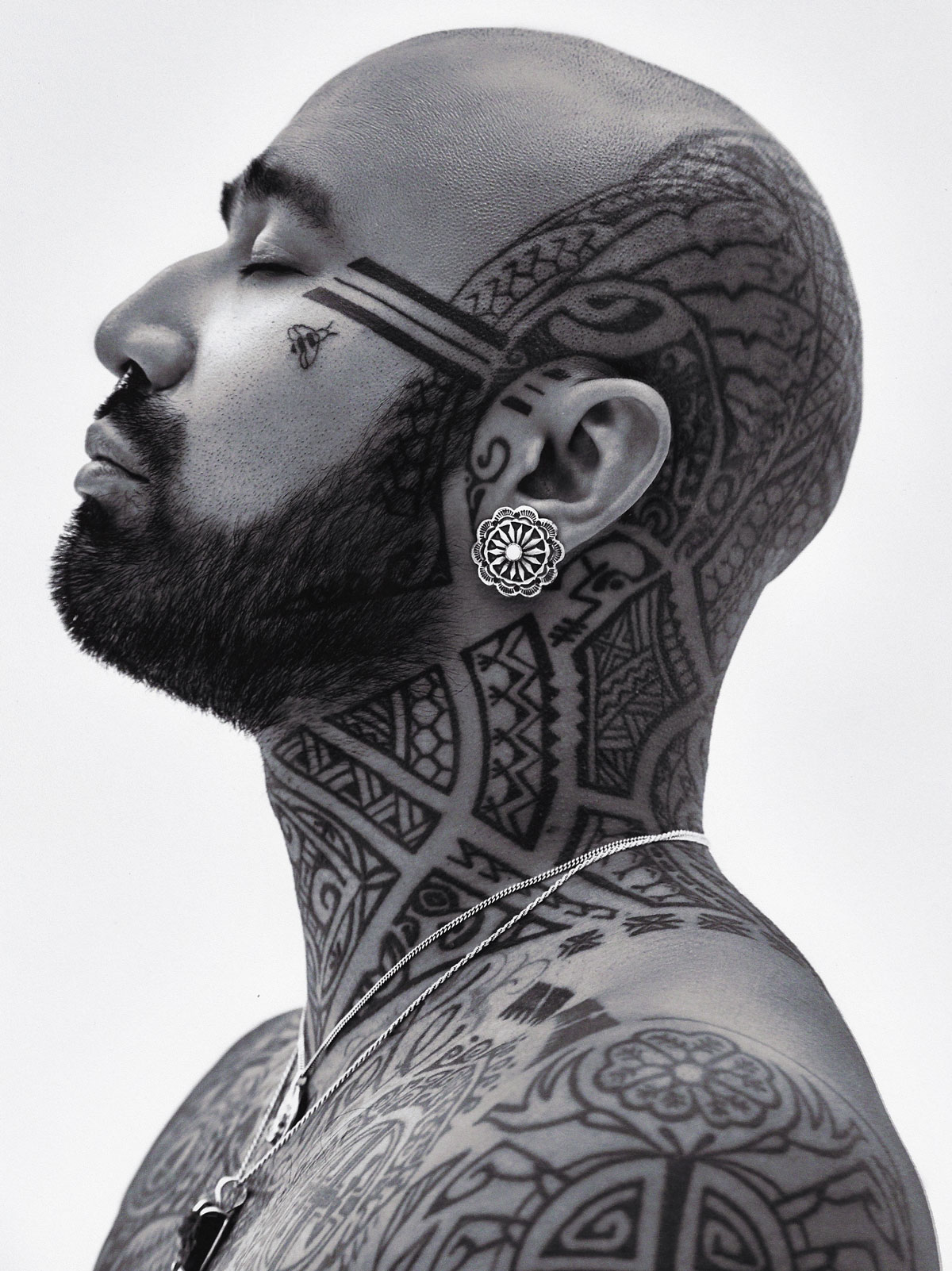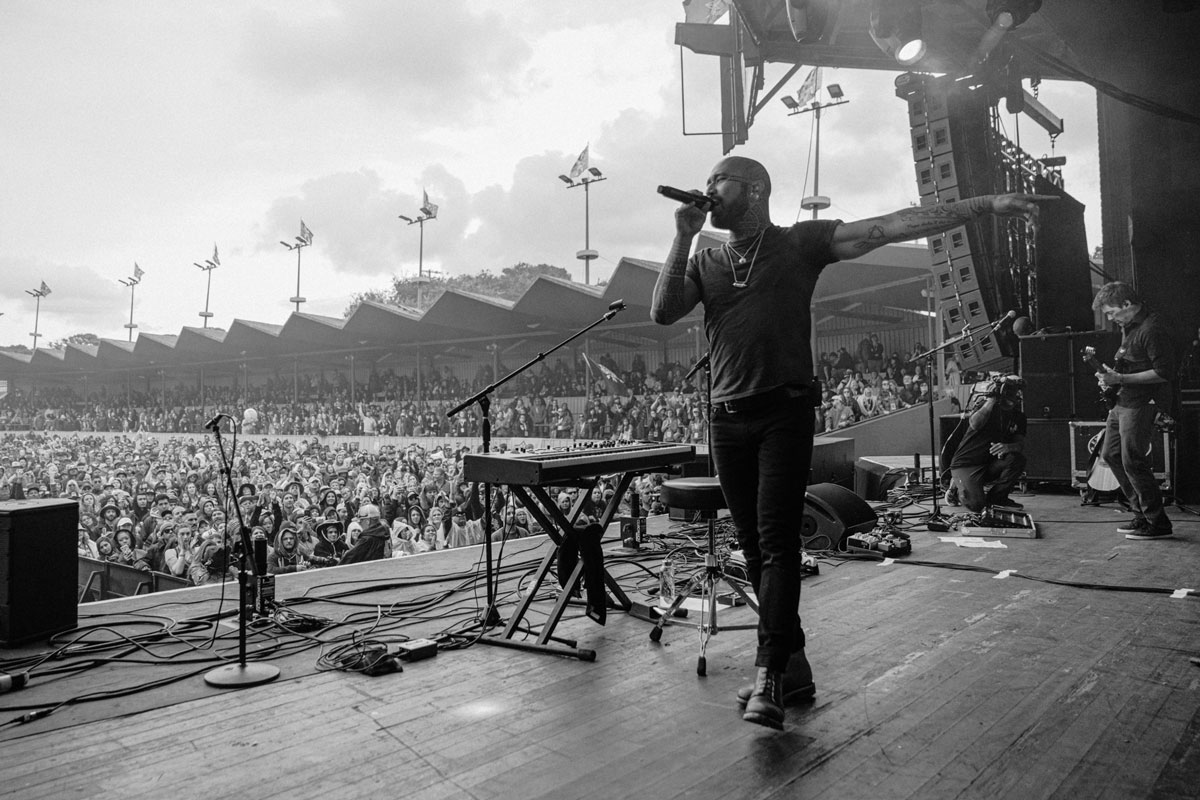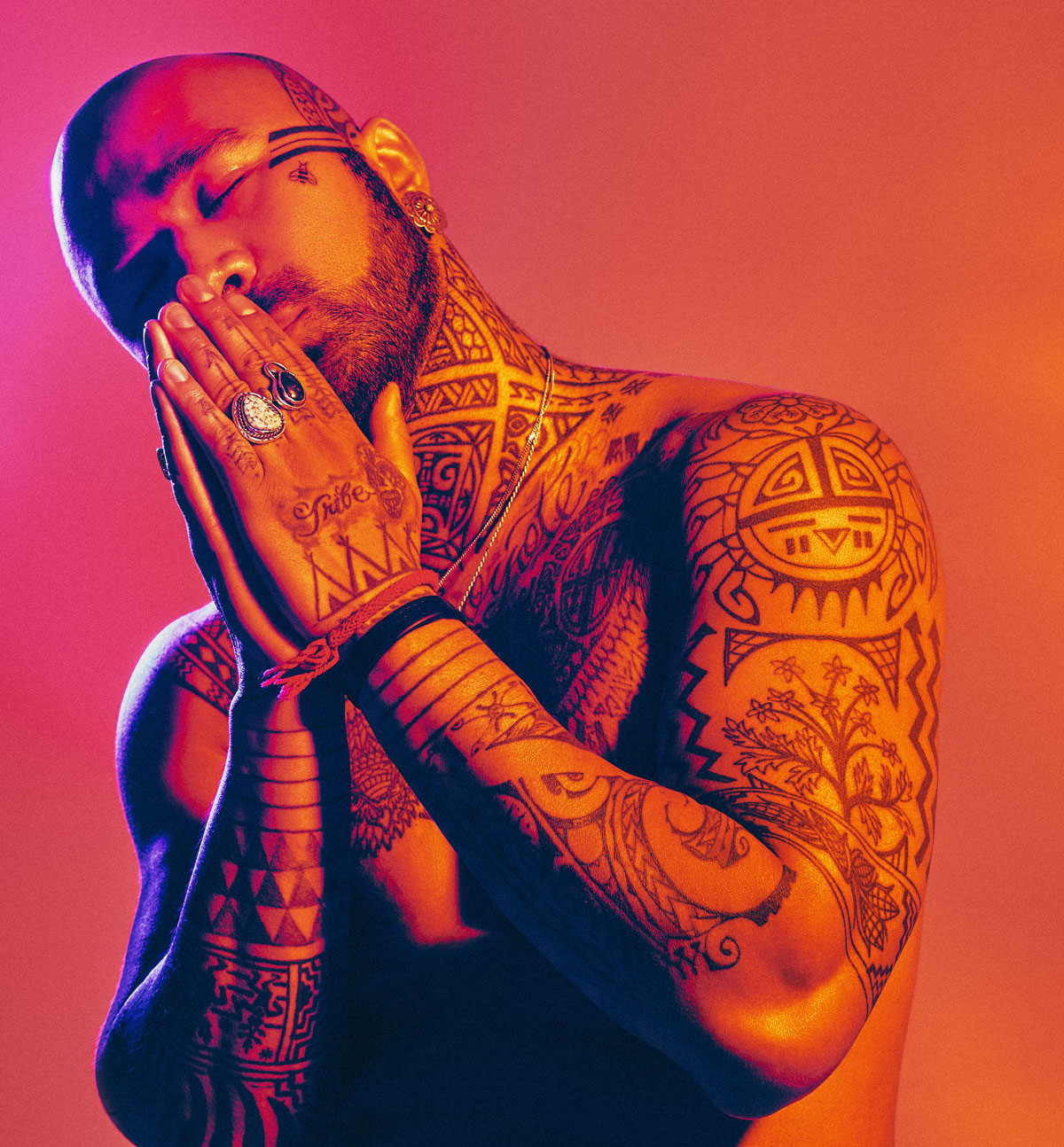Nahko Bear: “The journey with the guitar is never-ending - I'm always learning something new”
The Nahko and Medicine For The People frontman on becoming a guitarist, the power of storytelling and how one new chord can change everything

Nahko Bear’s songwriting could be described in any number of ways but one way to think of it is as storytelling in pursuit of self discovery and communal healing.
Whether his compositions are pared down and presented on acoustic guitar or delivered in the company of Medicine for the People - with horns, violin, full band - they are typically imbued with a sense of spiritualism.
Stylistically there is a restlessness to Nahko’s writing, a sensibility gleaned from his travels, leaving home at 17, moving to Alaska, then Hawaii, on the road reading Kerouac and listening to Dylan, but maybe also from his search of identity.
Nahko’s songwriting interrogates his sense of self, exploring his lineage as a sixth-generation Apache, born to a Puerto Rican/Native American mother and a Filipino father, and adopted by a white, Christian family and raised in Oregon. Again, it all comes back to the idea of discovery, healing, the stories we tell and those we are told.
One of the first things Nahko did when he moved back to Oregon was build a sweat lodge on his land. Nahko and Medicine for the People’s latest album, Take Your Power Back, draws upon his experiences in the sweat lodge, finding enlightenment in the heat and the dark of Native American ceremony.
“The whole album is speckled with references to ceremonies,” says Nahko. “There is a lot of mythology, a lot of spiritual storytelling in these songs. [The sweat lodge] is best described as a traditional North American Native practice of praying. It’s a metaphor for going back into the womb of mother nature and sacrificing your tears and your sweat.”
The whole album is speckled with references to ceremonies. There is a lot of mythology, a lot of spiritual storytelling in these songs
Inside you can pray for whatever you want to pray for, and prayer makes its way onto the album in the form of the Healing Song. Is What it Is (The Coyote Burial) came from one came from a vision, while Bend Like the Willow references the sweat lodge explicitly, with a chorus coming from a tribal elder’s words.
Get The Pick Newsletter
All the latest guitar news, interviews, lessons, reviews, deals and more, direct to your inbox!
“It is a super-fun track, very Afro-beat,” says Nahko. “And it has that Afro-Caribbean guitar licks in it. It’s one that we love to play.”
But before the sweat lodge, before Medicine for the People, before he folded Afro-beat, folk, pop and whatever into a life-affirming sound, before Hawaii, Alaska, traveling around with his acoustic and a notepad, there was the piano.
And that’s where Nahko’s story begins…
You didn’t start on the guitar. Where did your musical journey begin?
“I started playing piano when I was six years old and it was kind of laborious. It was supposed to be fun, then you take the lessons and it becomes like school work. My parents really wanted me to play classical music. I was really wanting to play all kinds of music but I just had to get going with the classical music.

“By the time I was 11 or 12, it got pretty serious, playing piano for two, three hours a day. It wasn’t until I was 14 years old when one of me neighbour buddies gave me a guitar. It was one of his old electric guitars, a big f-hole, jazz electric guitar. I can’t remember the brand but I think it was an old Japanese guitar.
"And then another friend of mine had given me a little Marshall mini-stack. [Laughs] Much to the dismay of my mom!”
Of all the things to bring home…
“You’ve got to remember, my family was pretty conservative and we weren’t really allowed to listen to secular music; everything was real gentle. Even the stuff I could play on the piano was meant to be traditional classical music or like church hymns, and being home-schooled, there was this, like, I did everything in my power to try and break free from anything that I was told to do!
I knew E minor because it’s two fingers, the easiest chord I could figure out, and I just remember playing E minor like crazy and thinking it sounded so cool!
"So trying you keep a kid in classical music, he’s gonna want to play rock ’n’ roll. [Laughs]”
Is there another instrument on this planet whose popularity owes so much to the onset of puberty?
“Hmm-hmm, exactly, being able to find that one thing that is rebellious. I remember sitting in my mom’s hallway with the Marshall mini-stack plugged in for the first time, and I turned it on, put the 1/4” in. I knew one chord.
"I knew E minor because it’s two fingers, the easiest chord I could figure out, and I just remember playing E minor like crazy and thinking it sounded so cool! It didn’t take me long to learn four chords, and I remember learning them at one of my friend’s houses.”
And so it was a question of fitting the guitar around piano practice?
“My mom tolerated the guitar. I couldn’t play it more than I played the piano. Of course I had to play the piano two hours a day. I just started in my own spare time. I think you could plug headphones into the Marshall stack.
“It’s interesting as I just recently went through a hard drive of mine and found the video of the first time I ever performed at an open mic with that guitar. It was in this little rural town. I had just got my driver’s license, or maybe my permit.
"I wasn’t allowed to go but I drove myself and my friend and played the first song I had written - and I have got it on tape. It’s so funny.”
You went traveling early in life. What influence did that have on your music?
“When I left high school at 17 years old, I moved to Alaska. I got a job as a musical director for this dinner theater - in the middle of nowhere in Alaska they were doing this theater show for these tourists at a resort and they needed a piano player.
I had listened to lots of oldies’ music growing up and had just started listening to mainstream music because, of course, it wasn’t allowed at the house
“This was the first time I had ever left home. I had never been anywhere outside of Oregon. I brought this acoustic guitar that I had bought. Instead of living with the actors from this theater group, I ended up living with the maintenance guys and the people who worked in the low-paid jobs - because they were all my age.
“I was 18 years old and the rest of these kids were all seasonal workers who had come to these resorts. I remember the first day I got there, these kids were playing their guitars on their porches. I showed up and one of my friends - who is still a friend of mine, one of my oldest friends - was playing Simon & Garfunkel on the porch.
“I was like, ‘I know that band. My dad listens to that band.’ I thought that was cool. He ended up introducing me to a lot of music during the next couple of years that really catapulted my songwriting style. I had listened to lots of oldies’ music growing up and had just started listening to mainstream music because, of course, it wasn’t allowed at the house.”
That must have been like the light going on in your head.
“When I broke out into the world I met musicians who introduced me to bands like Broken Social Scene, Arcade Fire, Wolf Parade, Bright Eyes... Talking Heads. So much music that I hadn’t heard of before - Sufjan Stevens! And it really inspired me.
"I wrote a lot of songs that summer, on that acoustic guitar, and I continued to write music over the next couple of years and ended up in Hawaii when I was 20 years old, and just continued my journey. It’s a long-assed story but that’s just a little piece of it. [Laughs]”
Usually we are totally unschooled when we make these discoveries, but having acquired your musical vocabulary from piano training, that must really have intensified that sense of inspiration.
One new chord would change everything. One new chord would mean a myriad of new transitions in songs
“Yeah, absolutely. I totally agree. That classical music and that temperature of first schooling in what music is about and what it feels like, what it feels like to sight read, what it feel like to listen with your ear… I could sight read music on piano and I could read and hear it, I could read and hear the keys of the music.
“But I still feel like an amateur guitar player. I couldn’t hang in a jam unless I knew the chords. I can’t solo per se. However, the journey with the guitar is never-ending, as it is with the piano and music in general. I am always learning something new. This is how I viewed it when playing the guitar - one new chord would change everything. One new chord would mean a myriad of new transitions in songs.
“I can remember when I learned how to tune my guitar D-A-D-F#-A-D, and I learned that style from listening to this band called the Tallest Man on Earth, and I listened to a lot of him for a long time. I thought these tunes were so amazing. And those voicings!
“My friend had taught me four chords to play when you are playing this tuning and it changed everything. I wrote four or five songs right away, and then most recently, for this album that is coming out, I was playing around with that same tuning, thinking I had worn it out [laughs], and here comes a different rhythm on a similar idea.”
Often that’s all it will take, a different beat, a different approach, and something you once thought stale is fresh again.
“Finding different rhythms within a simple chord progression helps you find another element of how a song can come through. With the last song on the album, Skin in the Game, it is so funny because I thought I had worn out this chord progression, and I thought I had worn out this tuning, but I hadn’t tried a different rhythm.
“Then I could add a different melody on top, right? The two go hand in hand. It’s interesting, man. The roots of what begins you in music, and how it can shift and shape you for the future and keep the door wide open.”
Part of being creative is having that awareness to remain open to new ideas.
There is a huge difference between being a musician and being a performer. And you don’t always get one and the same
“And the same goes for having done some theater when I was younger. I was never in the theater - I was just the guy in the back playing the piano, right - but I think that environment helped me break free of the introverted person, and push me onto the stage, and force me to become extroverted so that the entertainer in me could break free.”
For many of us, the idea of the stage is too alien, and performing requires us to present a part of us that is perhaps not naturally close to the surface.
“Oh massively. There is a huge difference between being a musician and being a performer. And you don’t always get one and the same. You could be watching a musician perform music but when you watch a musician being a performer, and an entertainer in that sense, that’s a very different type of person.”

Did you have to learn how to perform?
“Absolutely. Yep, I had to figure it out, lots and lots of practice, marking stage movements. I love to dance but I didn’t break free of my own body until recently, being more comfortable dancing without an instrument, or dancing with a guitar.
“There is a lot to think about, from playing the chords to singing the song. Once you know the song that well from playing with the band or by yourself, you know the instrument you are performing with so well that you get so comfortable with the guitar on or sitting at the piano and singing the song, then you can perform it.
“Now you can let go; it’s just second nature. You don’t even have to think about the song because you know you are gonna nail it. Now you can perform it. Now you can accentuate that message through through your body language, through the way you are delivering that to an audience.”
I think Alaska really dropped me into this vagabond feeling of just the guitar, your notebook, and your backpack
Because you are trying to inhabit a different sense of your own self, performance a bit like acting
“Yeah, and remaining in this authentic framework of, ‘I’m not trying to impress you. I am not trying too hard. I am just wanting to tell you a story through this performance, and through this song, and through these instruments. This is the full story and that’s how it goes.’”
Was it because of the traveling that you gravitated to the acoustic first?
“Oh yeah. There was nothing I could really bring with me as far as the piano is concerned, but the piano always seems to find me, which is hilarious. I would be traveling and out would pop up a random piano. But the guitar… I think Alaska really dropped me into this vagabond feeling of just the guitar, your notebook, and your backpack.”

Besides the harmonica, there’s surely few instruments more portable than the acoustic...
“It was a necessary item that you couldn’t live without because you could always drop in to writing something and expressing yourself on the road, and it became my tool to make a couple of bucks. I could busk. I could perform an open mic, and once GarageBand came out, I jumped right into recording to the computer, burning CDs and going from there. That was a whole new level to sharing what you were making. It was definitely easier with the guitar.”
What were you playing back then?
“I think my first acoustic was a Takamine, one of those 100-dollar guitars, and, man, I beat the shit out of that thing. But then my mom, for Christmas - my mom is so sweet - she bought me a Martin, which I still have.
"It’s a little out of shape but, man, that thing has been around! That Martin did a lot of work for a number of years before I retired it, but it has stood the test of time. Now I am just rambling on about guitars - is that all right?”
This is the place to ramble on about guitars. Please, continue… What did you use on the record?
You know how it is when a guitar just becomes a part of you? It’s like, okay, I can play anything on this. That’s my baby
“[Laughs] Yeah, right! For the acoustic songs, I played the Taylor. I went from playing the Martin and switched to Cole Clark for a number of years because the company was giving me guitars and I really liked them. I had two different ones. I had one that was real bright and one that had a lot deeper resonance in the bass, and I loved those guitars.
“But they are real big. I am a small little fella, y’know, and holding that thing was like reaching over and having to play this big ‘ol acoustic guitar, so it just didn’t fit me that well.
“I always wanted to try out a Taylor. Another musician friend of mine had been playing them for years, and the ones he had were real small with a cutaway, and it just had this real perfect, balanced sound. The pickup in it, and the acoustics of it when we recorded it, just sounded so full. Like, ‘God, I gotta try one of them.’
“So I got one of them and it has been my touring guitar for the last couple of years.’ It’s a cutaway, mahogany top as well - I like those mahogany tops - and it just fits me perfectly. You know how it is when a guitar just becomes a part of you? It’s like, okay, I can play anything on this. That’s my baby.”
What about electrics?
“The electric I used on the album was the D’Angelico [Deluxe Atlantic]. D’Angelico is such a cool company, great folks, and they gave this guitar to me when I was in New York a couple of years ago.
“I have had a Guild, previously. I had been playing Fenders, and over the last couple of years I have been experimenting with different guitars, different amps, different tones, and because I mainly play rhythm with the full band I really wanted something that would be full-bodied, that would cut through.”
Nahko and Medicine for the People’s new album, Take Your Power Back, is out via Side One Dummy / Medicine Tribe Records.
Jonathan Horsley has been writing about guitars since 2005, playing them since 1990, and regularly contributes to publications including Guitar World, MusicRadar and Total Guitar. He uses Jazz III nylon picks, 10s during the week, 9s at the weekend, and shamefully still struggles with rhythm figure one of Van Halen’s Panama.
Ozzy Osbourne’s solo band has long been a proving ground for metal’s most outstanding players. From Randy Rhoads to Zakk Wylde, via Brad Gillis and Gus G, here are all the players – and nearly players – in the Osbourne saga
“I could be blazing on Instagram, and there'll still be comments like, ‘You'll never be Richie’”: The recent Bon Jovi documentary helped guitarist Phil X win over even more of the band's fans – but he still deals with some naysayers

![Nahko And Medicine for the People - Lifeguard [Official Lyric Video] - YouTube](https://img.youtube.com/vi/oUW_D9RWtZw/maxresdefault.jpg)
![Nahko And Medicine For The People - Part Problem [The Village Sessions] - YouTube](https://img.youtube.com/vi/EnD1UMBubX0/maxresdefault.jpg)

![Nahko - Build a Bridge [Live at the Independent] - YouTube](https://img.youtube.com/vi/eoTX5ff9Ze0/maxresdefault.jpg)











